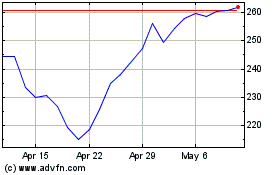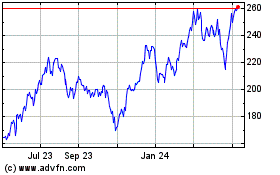By Don Clark and Tim Higgins
Qualcomm Inc.'s agreement to pay $39 billion for the world's
largest developer of chips for automobiles represents a huge bet on
cars becoming the next smartphone -- a way to roll together
communications and services once handled by dozens of other
devices.
San Diego-based Qualcomm isn't the first tech company to eye the
automotive industry for expansion, and the jury is still out on
whether the deal will help make cars smarter and safer. But it
shows the degree to which interest in turning cars into
digital-technology showcases have cast a gold rush-like spell over
chip-makers, software developers and venture-backed startups.
Its deal for NXP Semiconductors NV, the biggest to date in the
semiconductor industry, puts the spotlight on Qualcomm Chief
Executive Steve Mollenkopf, who 20 years ago started at the company
he now runs designing the unseen chips used in mobile phones.
A low-key manager who associates said isn't prone to making
brash statements and listens more than he talks, Mr. Mollenkopf, 47
years old, relishes the deal's ability to broaden Qualcomm's chip
portfolio -- and industrial horizons.
"This feels like the type of ambition that is Qualcomm," Mr.
Mollenkopf said in an interview on Thursday.
Qualcomm, unlike NXP, leaves chip manufacturing to others. Mr.
Mollenkopf noted his company has been learning more about
manufacturing issues through a wireless-component joint venture
with Japan's TDK Corp.
Thursday's deal values NXP at $110 a share, which represents a
34% premium over where NXP shares traded before The Wall Street
Journal reported on the talks Sept. 29. Including debt, the deal is
worth $47 billion.
NXP's position in the fast-growing automotive-chip market was a
key motivation for the deal, as cars gain a variety of
driver-assistance features and ultimately begin to drive
themselves.
Qualcomm already supplies the chips that bring cellular
connections to cars. It views NXP's chips and its sales connections
with auto makers and their major suppliers as a way to penetrate
that business much more quickly, said Mr. Mollenkopf.
"Our ability to sell to them expands just incredibly
dramatically as a result of the deal," he said. More broadly, NXP
would help Qualcomm become a much bigger player in a trend called
the Internet of Things -- Silicon Valley shorthand for adding
sensors, computing and communications to everything from home
appliances to office machines and farm tractors. NXP chips called
microcontrollers are widely used in many such applications.
NXP also has a leading position in chips for near-field
communications, a short-range wireless technology used for
applications such as completing payments on smartphones and
unlocking car doors.
Qualcomm derives most of its revenue from designing and selling
chips, but it earns more than half of its profits from licensing
its wireless patents to nearly all makers of mobile phones. It had
reasons to diversify beyond its processors and wireless chips for
smartphones, a business that has reached a plateau.
The hurdles are several: NXP has about 44,000 employees,
according to public filings, many more than the 30,000 Qualcomm
disclosed last year in its most recent annual report. NXP also owns
seven factories in five countries that turn silicon wafers into
chips.
In addition, analysts say, NXP has older factories that wouldn't
be easily adapted to make Qualcomm's chips. The company inherited
operations that began more than 60 years ago as part of the Dutch
giant Philips NV and Motorola Inc., which spun off its chip
business to create Freescale.
Mr. Mollenkopf said he expects veteran NXP executives to help
run the manufacturing operations and points to its successful
integration of other operations. "We get a lot of expertise coming
in," he said.
Qualcomm said it expects the purchase to add significantly to
its adjusted earnings. The company projects generating $500 million
of annualized run-rate cost synergies within two years after the
transaction closes.
The company will use offshore cash and new debt to finance the
deal, noting that the transaction structure "allows tax-efficient
use of offshore cash flow and enables Qualcomm to reduce leverage
rapidly."
On Wednesday, NXP reported third-quarter profit of $91 million,
or 26 cents a share, down from $361 million, or $1.49 a share, in
the year-ago quarter. However, the Dutch company pointed to its
operating income, excluding certain items, which rose to $691
million from $449 million.
Revenue surged 62% to $2.47 billion, in line with the company's
projections. However, excluding revenue from Freescale and other
adjustments, NXP said, revenue would have been down about 3%.
Qualcomm has yet to report its results for the fourth quarter
ended in September. For the June quarter, Qualcomm reported a
profit of $1.4 billion, or 97 cents a share, up from $1.2 billion,
or 73 cents a share, a year earlier. Revenue increased 4% to $6
billion.
The agreement is the latest in a string of mergers and
acquisitions in the semiconductor industry, which has seen more
than $200 billion in deals since the beginning of 2015. The deals
come as sales growth has faded at many of the once-burgeoning
companies as big chip markets -- such as those for smartphones and
personal computers -- have ebbed.
The deal is the largest in Qualcomm's history and comes after
activist investor Jana Partners LLC exited its investment in the
company earlier this year. Last year, Jana pressed the company to
consider splitting its chip unit from its patent business. Qualcomm
evaluated a split but ultimately decided against it.
Qualcomm pioneered what the semiconductor industry calls the
"fabless" model. That avoids the cost of operating and building
advanced fabs, which can cost more than $10 billion each for
facilities that can create the most advanced chips.
Industry executives say running factories requires a different
set of management skills than designing chips. Those include
tracking the age and performance of manufacturing equipment,
overseeing a supply chain of materials and managing production
workers, who are represented by labor unions in some NXP
locations.
--George Stahl, Eyk Henning, Maria Armental and Dana Cimilluca
contributed to this article.
Write to Don Clark at don.clark@wsj.com and Tim Higgins at
Tim.Higgins@WSJ.com
(END) Dow Jones Newswires
October 27, 2016 18:52 ET (22:52 GMT)
Copyright (c) 2016 Dow Jones & Company, Inc.
NXP Semiconductors NV (NASDAQ:NXPI)
Historical Stock Chart
From Mar 2024 to Apr 2024

NXP Semiconductors NV (NASDAQ:NXPI)
Historical Stock Chart
From Apr 2023 to Apr 2024
